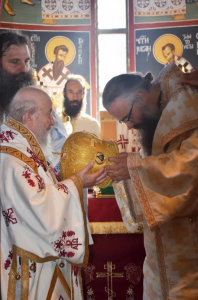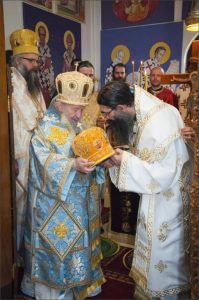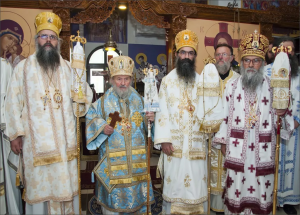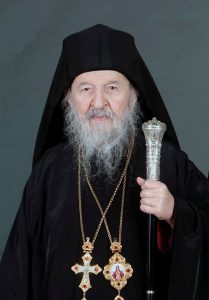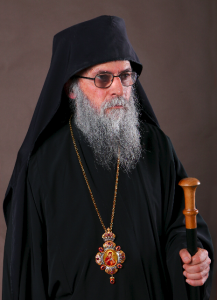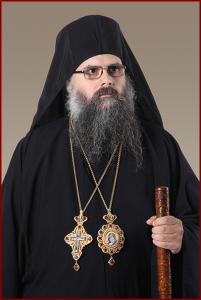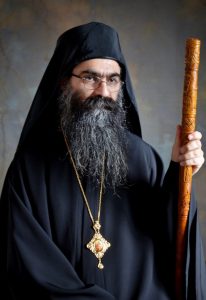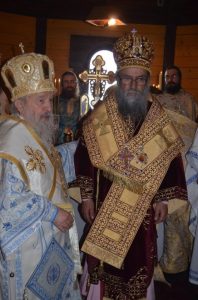 The ordination of Chorbishop Nikolai – on the left Bishop Artemije, on the right Chorbishop Nikolai
The ordination of Chorbishop Nikolai – on the left Bishop Artemije, on the right Chorbishop Nikolai
When Christ Our Lord, the Incarnate God, the Word and Son of God came down to earth and took on human nature, He deified and redeemed that nature. This is the Gospel truth which opens the door of theosis and therefore salvation to all people. Furthermore, this salvation of human nature as the most miraculous event in history of the world has given birth to yet another miraculous event – the creation of the Church of Christ. On the basis of His Father’s consent, Christ had in Himself created His Church on earth and He resides within Her like treasure, offering the whole of Himself, the whole of His ineffable Divine-Human Personality within the entirety of Her divine riches and omnipotence. Therefore, the Church is called the Body of Christ, whose Head is Christ Himself alone, Her eternal Head and Master. Thus, according to words addressed to us all in the Holy Spirit, St. Justin Popovich declares that: the Church is the God-Man Christ extended throughout the centuries and throughout the whole of eternity. In the Church – which is the treasury of our salvation and theosis – and by the Grace of the Holy Spirit, the whole Christ is joined, for She is founded upon the truth of the Gospels, the Apostolic-Patristic Orthodox Faith and the ecclesial life of Grace through the Holy Mysteries known as Sacraments. As one man consists of a soul and a body, so too does the Church consist of a “soul“, which is the Orthodox Faith. Furthermore, it also consists of a “body“, comprised of the church members, its laymen, the people of God united in one unique Orthodox Faith and sacred life of the Church through Grace and the Sacraments. For as the Holy Apostle Paul affirms: Now ye are the body of Christ, and members in particular (1 Corinthians 12:27).
Concerning this, St. John Chrysostom poses a question and provides the answer: Now what is this one body? It is the faithful throughout the whole world, which are, and which have been, and which shall be. And again, they who before Christ’s coming pleased God, are but one body. How so? Because they also knew Christ. Thus, true knowledge of Christ is made possible only through that same Faith, which was professed by Christ Himself during His sojourn on earth, where He proclaimed His words of salvation. This unchangeable Faith transmitted by Christ to His Apostles, was subsequently formulated and defined by the Holy Fathers and then handed down to us in the form of the Sacred Dogmas of the Orthodox Faith, which constitutes the “soul“ of the Church. Meanwhile, the very “body“ of the Church is constituted by church members, united through the Grace of the Holy Spirit in One Faith and the Sacraments. Therefore, we say that this external aspect of the Church – namely, the people of God led by the clergy and united through the Holy Spirit in the life of the Church with the Sacraments – constitutes the body of the Church. As the whole human being is composed of a sentient soul and a complete body, so too is the Church, which in Her most comprehensive sense, exists as a Divine-Human organism called the Body of Christ. For She is also composed of such a soul and such a body, as we have already explained. Indeed, whereas the Church cannot be easily defined – because no definition is capable of conveying the total depth of the God-Man and the breadth of the Holy Spirit within His Church – our preceding definition, or more appropriately analogy, while being very broad and simplified, is nevertheless clear enough to throw light upon the true content of the Church’s meaning.
Everything that was given as the Sacred Tradition of the Church by Christ Himself to His Holy Apostles and from them to the Holy Fathers through the Holy Spirit – the Sacred Dogmas, Sacred Canons, external features and the liturgical Tradition of the Church – virtually everything that the Church considers to be Her Sacred Tradition, was bequeathed to Her and to us Orthodox Christians within Her, for two main reasons:
1. For the protection of the Church’s wholeness of both “soul“ and “body“. Everything that is part of the Sacred Tradition of the Church was given for the protection of the Orthodox Faith – which is the dogmatic soul of the Church – that it may be safeguarded from heresy. This was necessary to preserve from spiritual predators, the flock belonging to the Church, which is the body of faithful people led by the clergy, all of whom are equally flag-bearers of the Orthodox Faith. Ultimately, the spiritual predators were both heretics and schismatics (if we consider that heretics are simultaneously schismatics in reality). This is confirmed by the fact that the sacred dogmas and dogmatic treatises of the Holy Fathers, were written precisely because of the necessity to oppose heresies, whenever they emerged throughout the Church’s long history of martyrdom. As Teachers of the Church, the Holy Fathers gave expression to these dogmas both individually and conciliarly at the Holy Ecumenical and Local Councils.
2. The preservation of the Church’s ability to fulfill the mission of human salvation entrusted to Her by the God-Man until the end of time, through profession of the true Orthodox Faith and the Sacraments. This salvation is intended for all those, who on the basis of their free will and actions resolve to accept it, and who become members of the Church by striving to obey the Lord’s Commandments.
This means that the whole Tradition of the Church has been established precisely for the twofold purpose described above, and has been shaped in such a manner, so as to ensure that the Church and Her people gathered inside Her – by adhering to this Tradition – could safely escape all the storms of history, which have so often disturbed the Church in this world and which continue to disturb Her even today albeit in vain, for She is the unsinkable Ark of Salvation for all Orthodox people baptized therein.
In order for the Church to fulfill Her mission, it is necessary that She is completely preserved from the prevailing storm in a two-fold way – preservation of dogmas which are Her “soul“, and preservation of Her “body“ – the people of God endowed with the Grace of the Sacraments. The dogmatic and canonical Tradition of the Church was especially given for the purpose of preserving the Church’s “soul“ and “body“, which means the preservation of the Orthodox Faith (thanks to which the Church is established), and the Grace of God in Her conciliar life sustained by the Sacraments (thanks to which the Church lives and exists). Throughout Her long history, the Church has continuously overcome a multitude of temptations and hardships, as well as diverse tribulations and onslaughts from both internal and external enemies. The enemies of the Church are those who try to kill Her “soul“ (i.e. those who corrupt the Orthodox Faith). Enemies also are those who attempt destroy Her “body“ (i.e. those who deny and devastate Her conciliarity, as expressed in the unity of the Faith and the Sacraments). Today, the Church is confronted by both kinds of enemies. On one side, there are the Ecumenist heretics, who corrupt the sacred Orthodox Confession of Faith given in the Creed. On the other side are gathered the Renovationists of Church Tradition (particularly Liturgical Tradition), who disrupt the unity of the Church in the Sacraments. In Her struggle with all these difficulties and owing to Her holy teachers and shepherds, the Church has accumulated immense experience, which was carefully formulated and ratified by Her Councils and thereafter treasured within Her Canonical Tradition. Therefore, all problems and difficulties encountered by the Church and those living within Her, can be overcome according to the experience of the most skilled champions of the Orthodox Faith, the Holy Fathers themselves, who are the true teachers, authorities and flag-bearers of Church Tradition. Theirs is the chief counsel by which our Diocese of Raška-Prizren and Kosovo-Metohija in Exile now abides and will, with God’s help, continue to abide in the future. Whenever we encounter any such problems or difficulties, it is not prudent to use human methods or reasoning to arrive at a solution. Instead, we must adopt the Patristic Tradition of the Church, because the Holy Fathers have already examined everything with wisdom, and have bestowed it upon us, as an inheritance for our benefit. Therefore, we must cleave to it, because there is no need for any innovations. We are obliged to listen to the voice of the Holy Fathers, to learn from their teachings, their Tradition and their experience – knowing that the voice and the paternal words of the Holy Fathers were given to us both very clearly and even as obligatory, in the form of the Holy Canons.
In accordance with the Orthodox understanding of the Church, every Orthodox diocese that is rooted in Sacred Tradition, the Apostolic Succession of Grace and the Orthodox Faith, constitutes one complete ecclesiastical unit and one unity, in a fully ecclesiastic-conciliar sense. To put it in simpler terms, every diocese represents one Local Church, while the Metropolitan and Patriarchal administrative systems emerged later, because of the need to improve the level of ecclesiastical organization. Our very own Diocese of Raška and Prizren has come under attack by the contemporary enemies of the Orthodox Faith, in the form of the Renovationists and Ecumenists mentioned earlier. Nevertheless, in spite of this unfortunate situation, our Diocese – headed by Bishop Artemije – has decisively continued to follow the way of the Holy Apostles and the Holy Fathers, with a firm intention to preserve and keep the Apostolic, Patristic, Ecclesiastical and Conciliar Orthodox Faith that was confessed by all Orthodox Christians always and everywhere.
The ordination of Chorbishop Maximus – on the left Bishop Artemije, on the right Chorbishop Maximus
Again, in order for the Church to fulfill this noble mission, it is necessary to have continuity in the preservation, the preaching and the confession of the Orthodox Faith as expressed in its sacramental life, which can be realized through an established clergy headed by a bishop. Hence, in the light of the current situation, it is not appropriate to simply confess Orthodoxy alone, but it is necessary to act in accordance with the precepts of Orthodoxy, that is, to enable the sacramental life of the Church on the basis of Her canonical Tradition, made possible thanks to the permanent existence and actions of Her clergy. Both of these elements are required (the Orthodox Faith and the sacramental life of the Church), for as we have previously explained, they are the “soul“ and the “body“ of the Church, enabling Her to exist and to live just like a complete human being does. In this situation and in accordance with the above argument, we do not wish to indulge our own speculations. Instead, we wish to act in accordance with the centuries-long Tradition of the Church and the Holy Fathers. Thus we have decided to avail ourselves of the Church’s Holy Canon Law, which is designated for situations similar to the one in which we find ourselves today, and we have concluded the following:
The generally accepted principle of Canon Law in the Church says that the Holy Canons – at least those designed for normal situations in the Church – are applied in their fullest sense, only during such normal situations, as in times when the Church enjoys the fruits of blissful peace.
The ordination of Chorbishop Naum – on the left Bishop Artemije, on the right Chorbishop Naum
Any study of ecclesiastical history, reveals that during the first centuries of its blossoming and expansion, the Church was also beset with many disturbances and difficulties. Apart from the general persecution by the pagan authorities of the time, one of the greatest disturbances for the Church was a plethora of heresies which had torn the Church asunder, inducing many riots, schisms and every kind of evil that could be imagined – given that heresy is conceived and enacted by Satan himself. Therefore, in order for the Church to cope with heresies and persecutions by the godless heretics and all others who had fought against God, She was obliged to create the rank of Chorbishops as a part of Her Sacred Tradition. The Church, as a caring mother, gave birth to the canonical tradition which allows the ordination of a chorbishop by one bishop who heads one diocese, in such times of struggle for the preservation of the Orthodox Faith and the Church, when several bishops were needed even within one diocese. The chorbishops are therefore, part of the Tradition that was born out of the long and bloody struggle of the Church with heretics and heresies, at a time when for the Church, the most crucial necessity was to defeat heresies, heretics and all other persecutors afflicting Her. Because one bishop could not achieve that goal by himself, he was allowed to ordain chorbishops for the needs of his diocese, i.e. bishop-concelebrators, who were his helpers in that struggle, as a part of his diocesan clergy. The primary asset in that struggle, was the preaching of the true Orthodox Faith and resistance to heretical false faiths (together with their eradication), while the preachers were Orthodox bishops and chorbishops together with their clergy.
During that time, at the pinnacle of the difficult struggle against heresies, heretics and other persecutors of the Orthodox Faith, and upon the soil that was soaked with the blood of the martyrs (from whom the Church’s experience of suffering is based), the aforementioned rank of Chorbishop (Auxiliary Bishop) emerged. The chorbishop was ordained by one bishop and upon him was conferred jurisdiction for cities and places around the episcopal see of that bishop. The long and ancient tradition concerning the rank of chorbishop in the Church is confirmed by the fact that this rank is mentioned in the following Canons: Canon 8 of the First Ecumenical Council, Canon 14 of the Seventh Ecumenical Council, Canon 13 of the Council of Ancyra, Canon 14 of the Council of Neo-Caesarea, Canon 10 of the Council of Antioch, Canon 57 of the Council of Laodicea, Canon 89 of St. Basil the Great.
From the left to the right: Chorbishop Maximus, Bishop Artemije, Chorbishop Naum and Chorbishop Nikolai
Bearing in mind that our Diocese of Raška and Prizren has found itself in similar circumstances in which the Church had frequently found Herself throughout history (at the centre of Her struggle against heresies, heretics and during persecutions of the Orthodox Faith); and having been taught by the wisdom and experience of the fighters for the Orthodox Faith (the Holy Fathers), we have resorted to this sacred tradition of the ordination of chorbishop, to meet the needs required by the Church in Her fight for survival, as She struggles against the heresies that have recently emerged. We have espoused this type of reasoning, in accordance with the sacred canonical tradition of the Church, as a Patristic and therefore divinely inspired solution for the truly difficult situation in which our Diocese has found itself within the Serbian Orthodox Church. This solution is supported by the fact, that this situation is worsening day by day.
For the above reasons, the Chorbishop Nikolai was ordained, whose official see is in Novi Pazar, while his actual although temporary see (due to persecution), will be in the monastery of St. Nicholas in Loznica (near Čačak). This see was chosen taking into account the fact that our Diocese and its clergy are in exile, in that the greatest part of our clergy is dispersed beyond the usual boundaries of our Diocese. In this way, as one Diocese, we continue to fight for the preservation of the Orthodox Faith and the Church of Christ, raising the level of readiness for combat, but without creating some new diocese or church. Instead, we are simply strengthening the clergy of our Diocese of Raška-Prizren and Kosovo-Metohija in Exile.
Bishop Artemije
Since this rank of chorbishop has remained unknown to the Serbian Orthodox Church until now, it is necessary to describe in more detail, what the rank of chorbishop actually means, according to the strict canonical definition.
A chorbishop is a bishop in a small town, most commonly in a village. Canon 14 of the Council of Neo-Caesarea talks best about the purpose of a chorbishop. This canon explicitly states that a chorbishop is ordained following the example of the Seventy Apostles and as such, he is a concelebrator of an eparchial bishop and has a task to care for the poor especially.
Chorbishop Nikolai
When interpreting this in his work “A General Treatise of the Canon Law“, the great Russian Canonologist Archimandrite John argues: “Chorbishops are named certainly in such a manner, so that it would be possible to differentiate them from the main diocesan bishops, who are descendants the Twelve Apostles. But this difference should be understood only in the sense of ecclesiastical administration, in which chorbishops had a lower position in comparison with diocesan bishops. Regarding the priestly dignity and spiritual episcopal rights, there is no reason to separate chorbishops from other bishops, because both of them had an episcopal dignity – and all bishops are equally heirs of the Holy Apostles“ (I, p. 371).
Since Her beginnings, the Church has followed the principle that prescribes a presence of only one bishop in one city (of course understood as one diocese). However, numerous canons and historical sources (for example, The Letter to the Church at Corinth of St. Clement of Rome), give evidence of the fact that together with a bishop of one city (which means a bishop of the city in one whole diocese), there had been present as his concelebrator and aide in a small suburban place a chorbishop, who in terms of Grace and Apostolic Succession, was equal to the urban bishop.
Chorbishop Maximus
The persecution to which the Church had been exposed throughout the centuries by the pagans as well as (if not more so) by the heretics, had necessitated the creation of chorbishops, because the Faith had to be preserved. The fact that the rank of chorbishop mostly emerged from the need to fight against heresies and heretics is best testified by the interpretation of the Canon 13 of the Council of Ancyra – as given by the bishop Nikodim Milaš: “Chorbishops (…) in the canons are mentioned for the first time in this canon of Ancyra, at the beginning of the 3rd century… Next time, they are mentioned in the Church History of Eusebius, where he talks about the Council of Antioch in 269… In the epistle of that Council (…) bishops of surrounding places and cities alongside with presbyters are mentioned, and in the interpretation (…) the author argues that these bishops of surrounding places (ἐπίσκοποι τῶν ὁμόρων ἀγρῶν) are chorbishops. The manner in which these and other canons of the first half of the 3rd century talk about chorbishops, proves that chorbishops in that period were widely known and that their tasks had been already determined, and that therefore, the notion of chorbishop refers to the first centuries of the Church. This creation of the rank of chorbishop was necessitated by the circumstances that prevailed in the Church at the time. In order to disseminate Christianity as much as possible and oppose the proliferation of the Gnostic heresy, especially during the early history of the Church, Orthodox bishops had been ordained everywhere, even in the smallest places, with a duty to preach the Faith of the Christ and accustom people to this Faith, to encourage the clergy in the struggle against the heretics and to ordain everywhere presbyters and other clergymen. Hence, there existed urban bishops and rural bishops (chorbishops).“[2]
Chorbishop Naum
Powers of a chorbishop are strictly determined: “Chorbishops shall have no right to ordain presbyters or deacons, but, moreover, not even city presbyters may they ordain, without being allowed to do so by the Bishop with letters in another diocese.“ (Canon 13 of the Council of Ancyra).
In this canon, by the term “another diocese“ a suburb is meant – one village and one area to which that village belonged, bearing in mind that this area was not conferred upon the chorbishop. A chorbishop could ordain the lower clergy in his village, in the beginning even deacons and presbyters without permission of the bishop of the city (bishopric) to which that village belonged. With written permission of a competent bishop, a chorbishop could ordain even in the city, a fact that confirms his episcopal Grace.
Later on, the powers of chorbishop were even more limited by the permission of the bishop of the city. A Chorbishop could independently appoint lower clergymen in his area, but presbyters and deacons he could not ordain even in his village (area) without episcopal permission and concelebration with the bishop of the city (diocese) – Canon 10 of the Council of Antioch.
If this Canon is followed to the letter, it means that a regular bishop (bishop of the city), is a main administrator of all ecclesiastical affairs in his diocese – as in the city, so in villages of his diocese. In this way, the principle “one city – one bishop“ would be preserved.
Afterwards, in peaceful times of the Church throughout history, it happened occasionally that chorbishops did not follow the canonical limitations of their powers in relation to the diocesan bishop. In order to cope with these inconsistencies, the Fathers of the Council of Antioch formulated Canon 10: “As for Auxiliary Bishops in villages or country towns, or so-called Chorepiscopi, even though they have received ordination by the laying on of hands, it has seemed best to the Holy Council that they should recognize their own limitations, and govern the churches subject to their jurisdiction, and be content with the cure and guardianship of these, and, on the other hand, to appoint anagnosts (or lectors), and subdeacons, and exorcists, and be content with their promotion, and not venture to ordain a Presbyter or even a Deacon, without the concurrence of the Bishop in the city to whom he and his district are subject. But if anyone should dare to transgress the rules laid down, let him be deposed from office and even from whatever honour he has been enjoying. An Auxiliary Bishop is to be made such by the Bishop of the city to which he is subject.“
In this canon, the provision according to which a chorbishop is to be ordained by an urban bishop to whom a chorbishop and his area are subject, is of great importance.
This provision was adopted for the needs of ecclesiastical order and represents an exception to the canonical principle, which prescribes that a bishop should be appointed by a whole Synod or at least two or three bishops – Canon 1 of the Apostles, Canons 4 and 6 of the First Ecumenical Council).[3]
The word “appoint“ in the Nomocanon of Saint Sava of Serbia is written as “поствление“ and has only one meaning – consecration to a rank, which in Greek means cheirotonia (“ordination“), i.e. cheirothesia.
For the purpose of clarity, we shall cite here the interpretation of this provision by Balsamon in his Athenian Syntagma (vol. III, pp. 143-4) translated from the Russian source: “And since some imbued with a haughty spirit wanted to be ordained as chorbishops by a metropolitan or a patriarch disregarding local bishops – hence, it was forbidden and it was prescribed that a chorbishop must be appointed by the bishop of the city, in order to be subject to this bishop and not underestimate him, as someone who did not ordain him to such a rank“.[4]
Due to the importance of this interpretation, we shall cite the translated interpretation from the Greek original: “Since some, immersed in arrogance, were of the opinion that they are not obliged to return to local bishops (emboldened by the fact that they were ordained by a metropolitan or a patriarch) – this was forbidden and it was determined that a chorbishop is ordained by the bishop of the city, that a chorbishop is subject to this bishop and that a chorbishop must not despise his bishop, as if a bishop is someone who did not bestow dignity on a chorbishop through the cheirotesia.“[5]
Therefore, this is not only about determination of place of service, but also about consecration to the rank of chorbishop, i.e. about ordination or cheirotonia. Due to his power of appointment of chorbishops, a bishop of the city obtained also the power to judge them, so the ancient canonical principle could be maintained – he who has the power to hire has also the power to fire. And that is the reason for the adoption of such a provision.
Deviation from the rule that a bishop should be appointed by a whole Synod or at least two or three other bishops, signifies not only the necessity of avoiding inconsistencies in the Church and preservation of indisputable power of a diocesan bishop in his diocese, but above all the ecclesiastical necessity for the rank of chorbishop.
As the persecution of the Church began to fade, so too did the influence of presbyters became more obvious. Some regional Churches, without the need for chorbishops, had adopted two following Canons: Canon 57 of the Council of Laodicea, according to which presbyters should be appointed in small places, and Canon 6 of the Council of Serdica, which confirms the previous provision, by saying that bishops should not be appointed in small places where one presbyter is enough, in order not to degrade thereby the dignity of episcopal rank.
These canons lay down the rule that states it would be not appropriate for the episcopal dignity, if bishops are appointed in small places and villages, where it was sufficient to appoint periodeutes, such as protopriests for the needs of the people.
The Council of Laodicea, however, underlines that existing chorbishops are not allowed to do anything without permission of an urban bishop. In other words, neither do existing chorbishops lose their dignity or service, nor are they obliged to move to big cities, nor is their rank considered uncanonical.
This is important if we want to understand the character of the aforementioned Canons 57 of the Council of Laodicea and 6 of the Council of Serdica. These canons do not have an imperative character, on the basis of which chorbishops should be abolished as an uncanonical institution. Whether or not to appoint chorbishops is a matter of ecclesiastical necessity. They are created whenever they are needed and as a result of this argument, they still existed in the Church of Cyprus as recently as 2014.
The Diocese of Raška-Prizren and Kosovo-Metohija was expelled from its canonical area of Raška, Kosovo and Metohija. It was expelled by the combined forces of the Ecumenist hierarchy of the Patriarchate in Belgrade and the secular political regime of the Republic of Serbia back then, in coordination with the Regime of Occupation in Kosovo and Metohija. The diocesan bishop, monks, clergymen and pious flock have found a refuge in other parts of Serbia, in small places and in catacombs, where new priests and believers have joined them, longing for the authentic teachings of St. Sava of Serbia.
Because of the rapid expansion of the Diocese and the constant increase of the pious flock, the administration of ecclesiastical matters has become more complicated in the Diocese of Raška-Prizren and Kosovo-Metohija in Exile. On this account, the necessity for the appointment of a chorbishop who would be canonically dependant on his consecrator Bishop Artemije of Raška-Prizren in Exile, was becoming more than obvious. In this way, the episcopal dignity is not degraded, because the Stara Raška region (bestowed to the chorbishop Nikolai), is actually the area of the ancient Eparchy of Raška, which was in those times, a metropolis with the metropolitan see in Novi Pazar and coincides with the contemporary municipalities of Novi Pazar and Tutin. In the context of exile, he has pastoral supervision of believers and catacombs in the municipality of Čačak and the following administrative districts of Serbia: Zlatibor, Moravica, Raška, Rasina, Toplica, Nišava, Jablanica, Pčinja and Pirot. Furthermore, the honour enjoyed by the catacomb serving as the temporary see of the Chorbishop in the eyes of the pious people – namely, the monastery of St. Nicholas of Myra in Loznica near Čačak – is immediately second in honour to that enjoyed by the temporary see of the Bishop of Raška-Prizren and Kosovo-Metohija in Exile – namely, the monastery of St. John the Forerunner in Ljuljaci.
Consequently, not one single canon was violated by the ordination of Chorbishop Nikolai. Neither will any canons be violated by subsequent ordinations of new chorbishops, particularly if such ordinations are required by the ecclesiastical circumstances in the Diocese of Raška-Prizren. In this manner, plainly and without compromise, the Orthodox Faith is protected from the Pan-Heresy of Ecumenism.
The Office of the Bishop of Raška-Prizren and Kosovo-Metohija in Exile
+ Artemije
——————————————
[1] In the meantime, two more Chorbishops were ordained (Maximus and Naum).
[2] Правила Православне Цркве, с тумачењима, епископ Никодим Милаш, књига 2, Нови Сад 1896. год, стр. 15.
[3] Nikodim Milaš did not cite this provision appropriately, nor did he at all interpret it, even if it deserves attention. Milaš cites the aforementioned provision as: ‘A chorbishop and his place of service, will be determined by the bishop of the city, on which that place depends.’ It should be noted that Milaš’ citation of this provision does not exist in any of the volumes of canon law. For Milaš, it was controversial to translate ‘appoints’ (поставља).“
[4] “А как некоторые из тщеславия, старались получить рукоположение в хорепископы от митрополита, или от патриарха, не обращаясь к местным епископам; то запрещено и это, и определено, чтобы хорепископ был поставляем от епископа города, дабы был в подчинении ему и не уничижал его, как не давшего ему рукоположения в сей сан.“ Taken from – http://agioskanon.ru/sobor/011.htm
[5] Athenian Syntagma, vol. III, pp. 143-4.
 ЕПАРХИЈА РАШКО-ПРИЗРЕНСКА У ЕГЗИЛУ Званична интернет презентација са благословом Његовог Преосвештенства Епископа рашко-призренског у егзилу Г.Г. Артемија
ЕПАРХИЈА РАШКО-ПРИЗРЕНСКА У ЕГЗИЛУ Званична интернет презентација са благословом Његовог Преосвештенства Епископа рашко-призренског у егзилу Г.Г. Артемија

